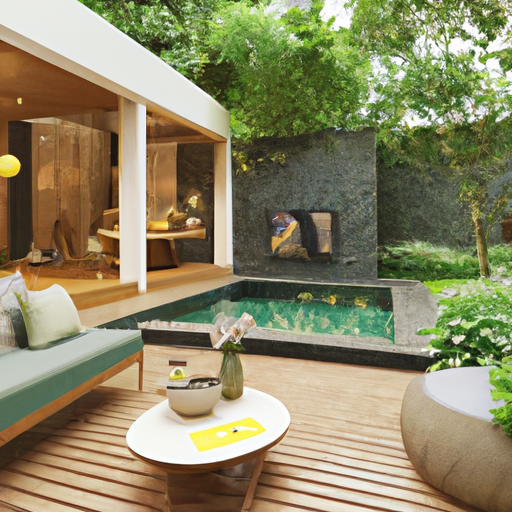Integrating Nature into Your Home Design: Top Strategies and Techniques
Designing a home that blends seamlessly with its natural surroundings is an increasingly popular trend among homeowners and architects alike. This approach not only creates a visually stunning living space but also promotes a sense of harmony with the environment, fostering a deeper connection to the natural world. Integrating nature into your home design can be achieved through a variety of strategies and techniques, ranging from the choice of materials and colors to the incorporation of natural elements and features. In this article, we will explore some of the top strategies and techniques for designing a home that blends with its natural surroundings.
One of the most important aspects of designing a home that blends with its natural surroundings is the choice of materials. Using natural materials such as wood, stone, and clay can help to create a sense of continuity between the home and its environment. These materials not only have a timeless aesthetic appeal but also offer numerous practical benefits, such as durability and energy efficiency. Additionally, using locally sourced materials can further enhance the connection between the home and its surroundings, as well as reduce the environmental impact of construction.
The choice of colors is another crucial factor in designing a home that blends with its natural surroundings. Opting for a color palette that reflects the hues found in the surrounding landscape can help to create a sense of harmony and unity between the home and its environment. Earthy tones such as browns, greens, and grays are particularly effective in achieving this effect, as they evoke the colors of soil, foliage, and rocks. However, it is important to strike a balance between blending in and standing out, as a home that is too camouflaged may appear dull and uninviting.
Incorporating natural elements and features into the home design can also help to create a seamless connection between the indoor and outdoor spaces. This can be achieved through the use of large windows and glass doors, which not only allow for an abundance of natural light but also provide unobstructed views of the surrounding landscape. Skylights and clerestory windows can also be used to bring natural light into the home, creating a bright and airy atmosphere.
Another effective technique for integrating nature into your home design is the incorporation of greenery and water features. Indoor plants, green walls, and living roofs can help to purify the air, reduce stress, and create a sense of tranquility within the home. Water features such as ponds, fountains, and waterfalls can also contribute to a calming and serene atmosphere, as well as provide a natural habitat for local wildlife.
The layout and orientation of the home are also important factors to consider when designing a home that blends with its natural surroundings. Positioning the home to take advantage of natural features such as sunlight, shade, and prevailing winds can not only enhance the home’s connection to its environment but also improve its energy efficiency and overall comfort. Additionally, designing the home to follow the contours of the land can help to minimize the impact of construction on the landscape and preserve the natural topography.
In conclusion, designing a home that blends with its natural surroundings requires a thoughtful and holistic approach, taking into consideration factors such as materials, colors, natural elements, and layout. By employing these strategies and techniques, homeowners and architects can create a living space that not only looks beautiful but also promotes a sense of harmony with the environment and fosters a deeper connection to the natural world.
Embracing the Outdoors: Creating Seamless Transitions Between Indoor and Outdoor Spaces

Designing a home that blends with its natural surroundings is an art that requires a delicate balance between aesthetics, functionality, and sustainability. The goal is to create a living space that not only complements the environment but also enhances the overall experience of the inhabitants. One of the key aspects of achieving this harmony is by creating seamless transitions between indoor and outdoor spaces. This not only allows for a more fluid and organic connection with nature but also promotes a healthier and more sustainable lifestyle.
To begin with, it is essential to carefully consider the location and orientation of the house. This involves studying the topography, vegetation, and climate of the site to ensure that the design takes full advantage of the natural features and resources available. For instance, positioning the house to maximize natural light and ventilation can significantly reduce energy consumption and create a more comfortable living environment. Additionally, incorporating elements such as green roofs, living walls, and rainwater harvesting systems can further enhance the sustainability of the home while also contributing to its visual appeal.
Next, it is crucial to select materials and finishes that are not only durable and low-maintenance but also blend well with the surrounding landscape. This can be achieved by using locally sourced materials such as stone, wood, and clay, which not only have a lower environmental impact but also help to create a sense of belonging and continuity with the site. Moreover, opting for natural and earthy tones for the exterior and interior finishes can further enhance the connection with the outdoors and create a more harmonious and cohesive design.
One of the most effective ways to create seamless transitions between indoor and outdoor spaces is by incorporating large windows, sliding doors, and skylights into the design. These elements not only provide ample natural light and ventilation but also help to visually connect the interior spaces with the surrounding landscape. Furthermore, they can be strategically placed to frame specific views or features, such as a garden, a water body, or a distant mountain range, thereby creating a dynamic and ever-changing backdrop for the living spaces.
Another important aspect of embracing the outdoors is the design of outdoor living spaces, such as terraces, patios, and balconies. These areas should be carefully planned and integrated with the interior spaces to create a seamless flow and encourage interaction between the two. This can be achieved by using similar materials, finishes, and design elements for both indoor and outdoor spaces, as well as by providing adequate shade and shelter to ensure year-round usability. Additionally, incorporating features such as outdoor kitchens, fireplaces, and seating areas can further enhance the functionality and appeal of these spaces.
Finally, the landscaping and planting scheme should be carefully designed to complement and enhance the overall design of the home. This involves selecting native and drought-tolerant plants that require minimal maintenance and water consumption, as well as creating a variety of outdoor spaces that cater to different activities and moods. For instance, a lush and colorful garden can provide a vibrant and stimulating setting for social gatherings, while a serene and contemplative courtyard can offer a quiet and introspective retreat.
In conclusion, designing a home that blends with its natural surroundings requires a holistic and integrated approach that takes into account the site, materials, and design elements, as well as the needs and preferences of the inhabitants. By creating seamless transitions between indoor and outdoor spaces, it is possible to achieve a harmonious and sustainable living environment that not only respects and enhances the natural landscape but also promotes a healthier and more fulfilling lifestyle.
Sustainable Living: Incorporating Eco-Friendly Materials and Practices in Your Home Design
Designing a home that blends with its natural surroundings is an increasingly popular trend in sustainable living. This approach not only creates a harmonious and visually appealing living space but also promotes eco-friendly practices and materials. By incorporating sustainable design elements, homeowners can reduce their environmental impact, conserve resources, and create a healthier living environment. In this article, we will explore various ways to design a home that seamlessly integrates with its natural surroundings, while also incorporating eco-friendly materials and practices.
One of the first steps in designing a home that blends with its natural surroundings is to carefully consider the site and its unique features. This includes analyzing the topography, vegetation, and climate of the area, as well as any existing structures or landmarks. By understanding the site’s characteristics, homeowners can make informed decisions about the placement and orientation of their home, which can significantly impact energy efficiency and overall sustainability.
For example, positioning a home to take advantage of natural sunlight can reduce the need for artificial lighting and heating, while also providing a connection to the outdoors. Similarly, incorporating passive solar design principles, such as large south-facing windows and thermal mass materials, can help to regulate indoor temperatures and reduce energy consumption. Additionally, designing a home with a smaller footprint and utilizing vertical space can minimize site disturbance and preserve the natural landscape.
Another important aspect of designing a home that blends with its natural surroundings is the selection of eco-friendly materials. This includes choosing materials that are locally sourced, sustainably harvested, and have a low environmental impact. Examples of such materials include reclaimed wood, recycled metal, and natural stone. By using these materials, homeowners can reduce the carbon footprint of their home, support local economies, and create a unique aesthetic that reflects the surrounding environment.
In addition to selecting sustainable materials, homeowners should also consider incorporating energy-efficient systems and appliances into their home design. This can include installing solar panels, geothermal heating and cooling systems, and energy-efficient windows and doors. These features not only reduce a home’s environmental impact but can also result in significant cost savings over time.
Water conservation is another crucial aspect of sustainable living and can be achieved through various design strategies. For instance, incorporating a rainwater harvesting system can provide a sustainable source of water for irrigation and other non-potable uses. Additionally, using native plants and drought-tolerant landscaping can reduce the need for supplemental watering, while also creating a seamless connection between the home and its natural surroundings.
Indoor air quality is another important consideration when designing a home that blends with its natural surroundings. This can be achieved by using low-VOC (volatile organic compound) paints and finishes, as well as incorporating natural ventilation strategies, such as operable windows and skylights. By prioritizing indoor air quality, homeowners can create a healthier living environment and reduce the risk of respiratory issues and other health concerns.
In conclusion, designing a home that blends with its natural surroundings involves a holistic approach that considers site selection, eco-friendly materials, energy efficiency, water conservation, and indoor air quality. By incorporating these principles into their home design, homeowners can create a sustainable living space that not only complements the natural environment but also promotes a healthier and more eco-friendly lifestyle. As the demand for sustainable living continues to grow, it is essential for homeowners to consider these factors when designing their dream home, ensuring a harmonious and environmentally responsible living space for generations to come.
Q&A
Question 1: What are the key elements to consider when designing a home that blends with its natural surroundings?
Answer 1: The key elements to consider are the choice of materials, the architectural style, and the integration of natural features such as vegetation, water, and topography.
Question 2: How can the choice of materials help in blending a home with its natural surroundings?
Answer 2: Using locally sourced, natural materials like stone, wood, and clay can help the home blend seamlessly with the environment, while also promoting sustainability and reducing the overall environmental impact.
Question 3: What are some ways to integrate natural features into the design of a home?
Answer 3: Integrating natural features can be achieved by incorporating elements like green roofs, living walls, large windows for natural light, and designing the home’s layout to follow the contours of the land, preserving existing trees and vegetation.
Conclusion
In conclusion, designing a home that blends with its natural surroundings involves careful consideration of the site’s topography, local materials, and native vegetation. Incorporating sustainable design principles, maximizing natural light, and creating seamless indoor-outdoor connections further enhance the harmony between the built environment and the natural landscape. By respecting and embracing the unique characteristics of the site, a well-designed home can achieve a sense of belonging and coexistence with its surroundings, resulting in a visually appealing and environmentally responsible living space.


